Introduction
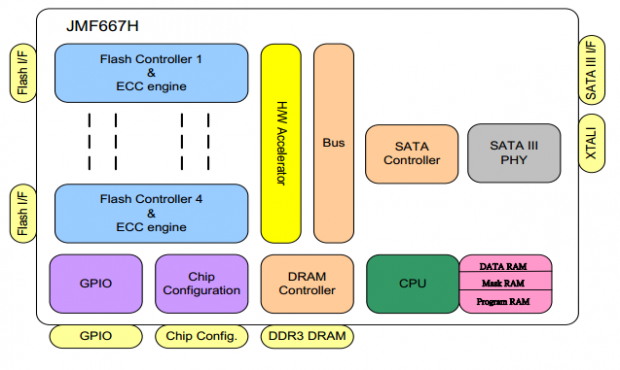
It's that time of year again. Computex is just days away, and my email box is full of little bits and pieces of rumor news, like a potential Samsung 850 SSD launch. Computex is also a time when we get to go hands-on with SSDs still in early testing. In years past, we've had a booth section roped off for a very public beta test, had SSDs handed to us with a nod and a wink, and walked through an actual SSD manufacturing plant to see how SSDs are made.
We already have several unreleased SSDs waiting for our arrival. Computex beta testing will be epic this year. JMicron, the company responsible for making DRAM buffers a marketable feature on solid state drives, thought ahead and delivered four reference boards in advance of Computex. All four SSDs use the new JMicron JMF667H controller, the same controller we tested already in the Kingfast C-Drive F8 and, more recently, the Transcend SSD340. Yes, we have already tested this controller twice in two retail products. This whole leak thing is something new for JMicron, but they are making an effort.
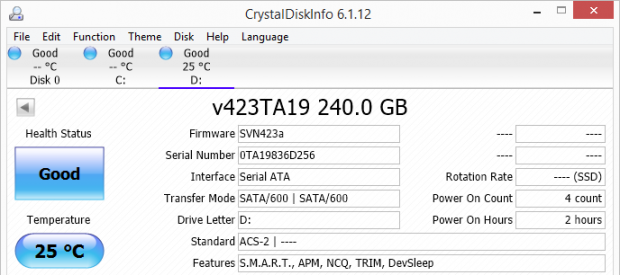
The four samples we are testing today are actually new, but in firmware and different flash configurations. Our retail samples shipped to us with an earlier firmware. One had Toshiba 19nm (26x19mm die) flash and the other had Micron 20nm L85. Today, we're using updated firmware paired with Toshiba's new A19 (19mm x 19.5mm die), IMFT's L85A, and IMFT's L85C flash. The new firmware is different on all four drives since it's custom tuned for each flash type.
We've talked about Toshiba's new A19 flash before. The short version is Toshiba shrunk the die size, but it's still considered 19nm. Nailing down the difference between L85A and L85C was a bit tricky.
L85C is interesting because it brings SLC mode to the table, much like SanDisk's nCACHE and Samsung's Turbo Write. Just having the ability for the flash to work in SLC mode isn't that great of a feat for a manufacturer, unless the controller can take advantage of it.
JMicron JMF667H Reference Designs
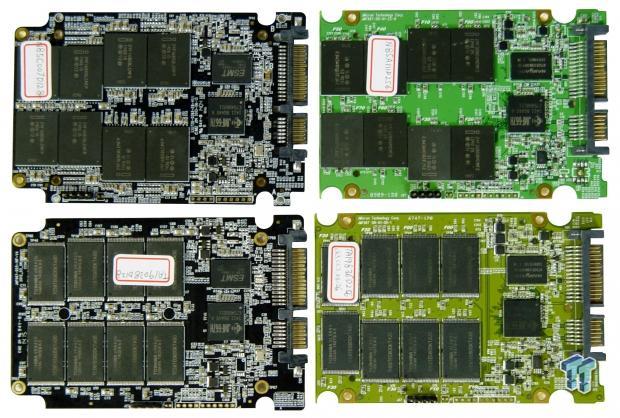
As stated in the introduction, we have four reference design boards from JMicron. Two of the drives use Toshiba A19 flash, a 128GB drive and a 240GB drive. Our sample with L85C is 128GB, and our L85A sample is 256GB. Ideally, we would have both capacity sizes with each flash type and six drives total. We'll work on that and possibly refresh with the final firmware.
JMicron JMF667H with IMFT L85C 128GB
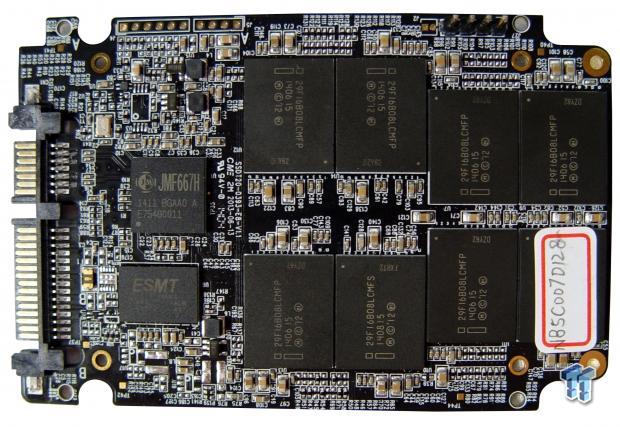
This model uses a JMicron JMF667H controller paired with eight IMFT L85C flash packages.
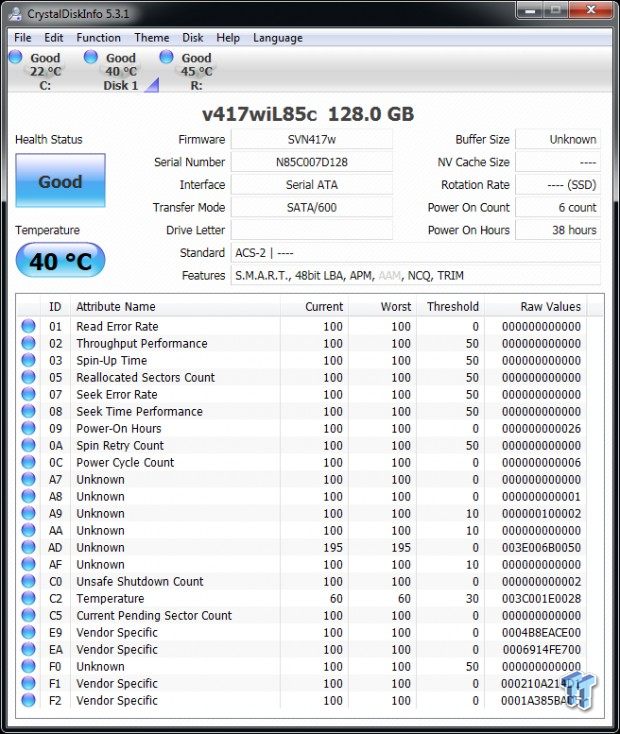
The firmware we tested is SVN417w.
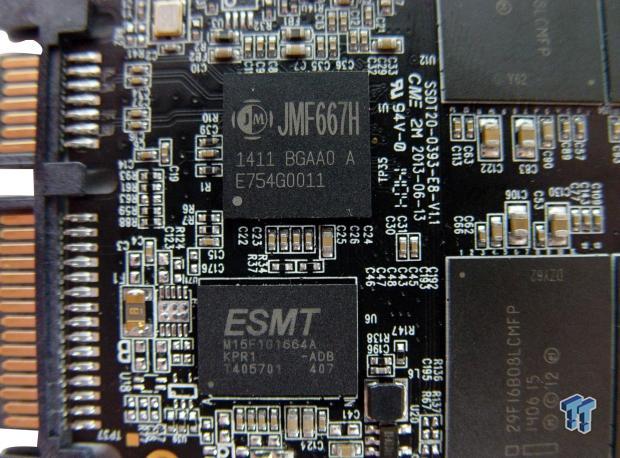
JMIcron used an Elite Semiconductor Memory Technology DDR3 SDRAM buffer on this unit.
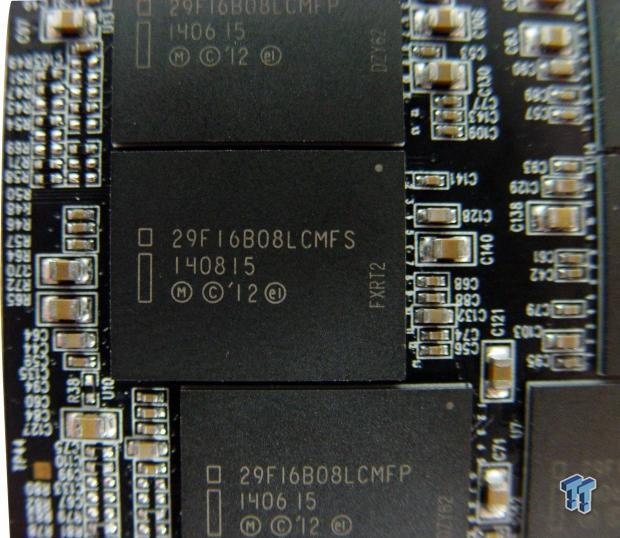
The eight IMFT 20nm NAND packages are marked 29F16B08LCMFS.
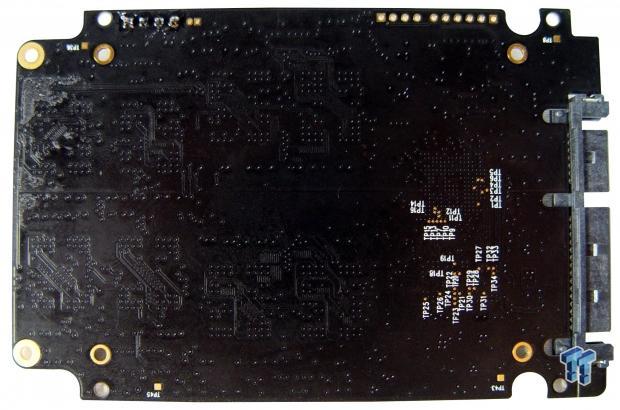
JMicron JMF667H with IMFT L85A 256GB
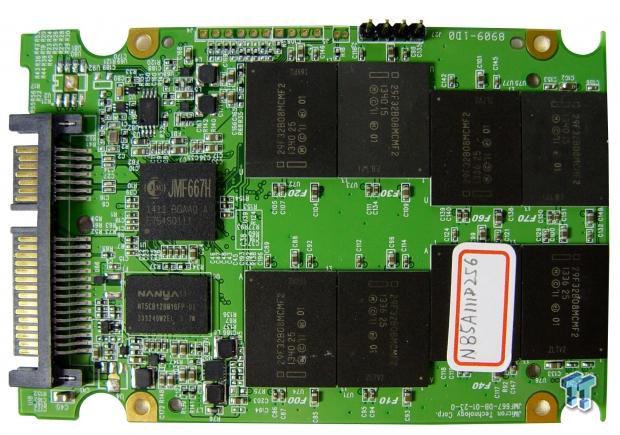
This model uses a JMicron JMF667H controller paired with eight IMFT L85A flash packages.
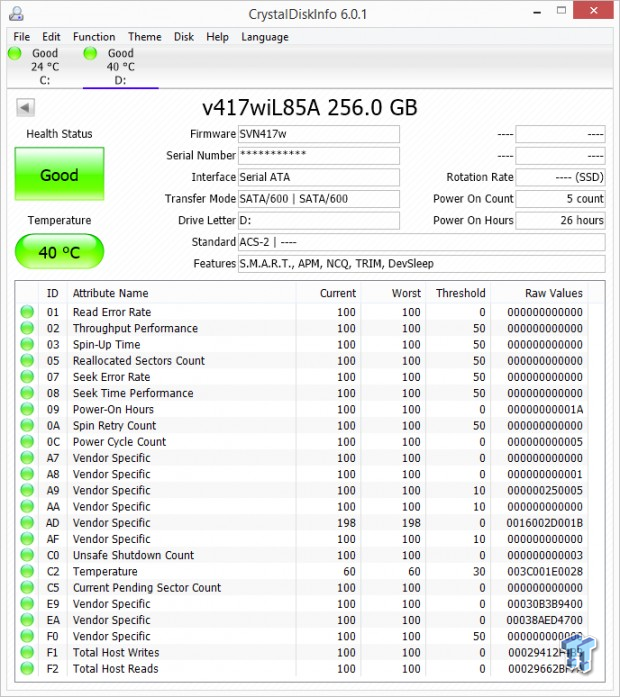
Like the 128GB model above, the firmware on this drive is SVN417w.
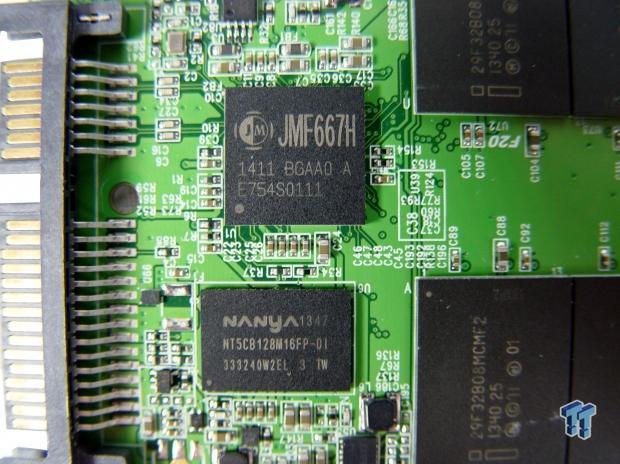
The 256GB model uses a 128MB NANYA DDR3 SDRAM buffer.
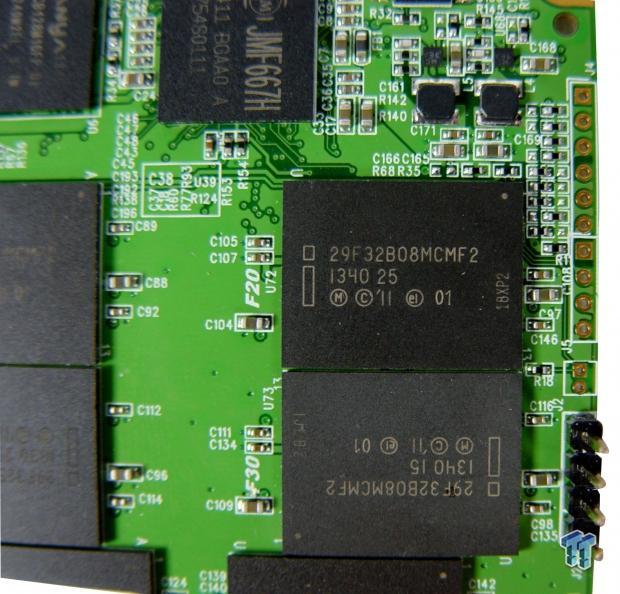
Eight IMFT 20nm L85A flash packages marked 29F32B08MCMF2 are on one side of the PCB, but pads for an additional eight are on the other side.
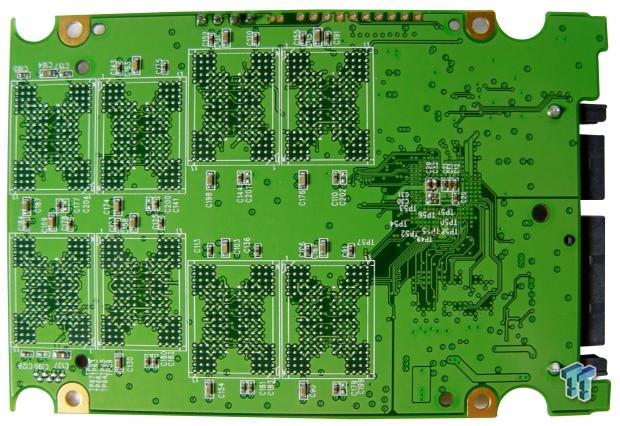
The 256GB L85A model doesn't populate the bottom pads.
JMicron JMF667H Reference Designs (cont.)
Now let's take a look at the JMF667H paired with Toshiba A19 single plane NAND.
JMicron JMF667H with Toshiba A19 128GB
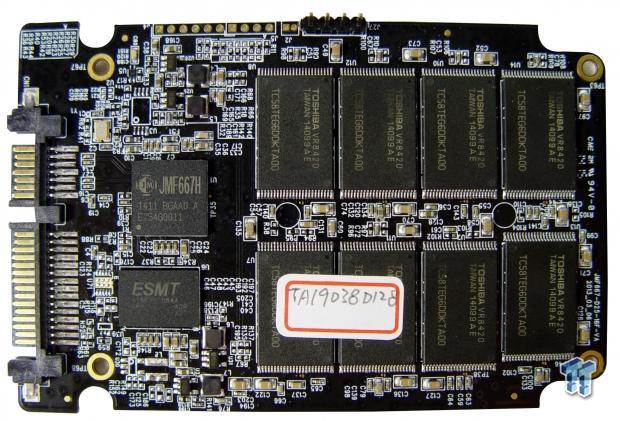
Armed with eight Toshiba 19nm A19 NAND packages, the first Toshiba based drive is 128GB.
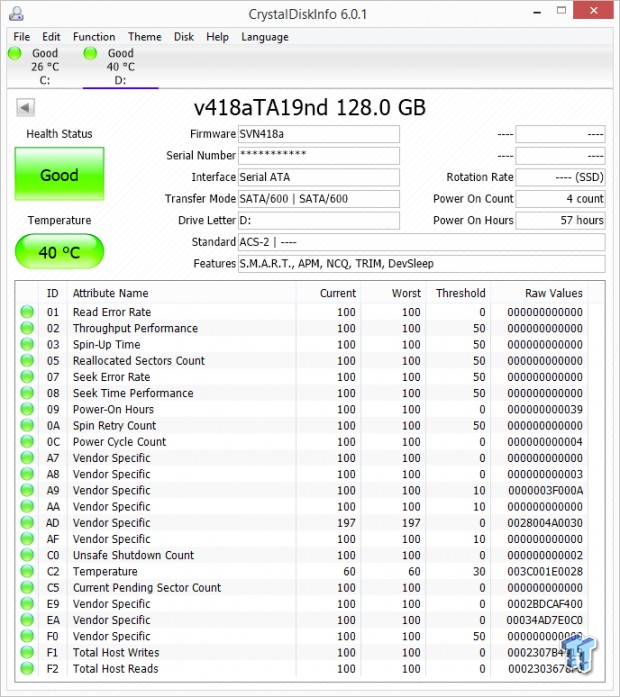
The firmware on this model is SVN418a.
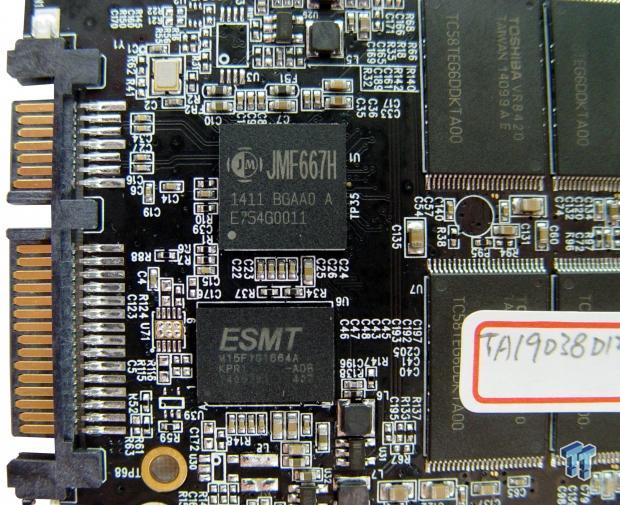
The same ESMT DDR3 SDRAM found on the L85C 128GB drive is also used on the Toshiba 128GB flash model.
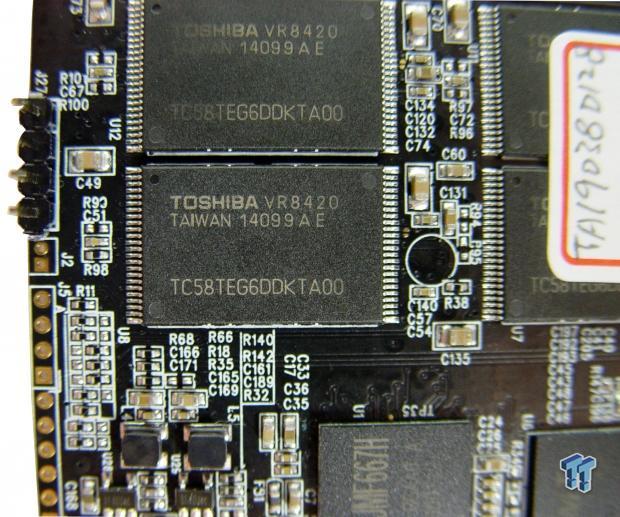
Sixteen Toshiba TC58TEG6DDKTA00 19nm A19 flash packages in total are used.
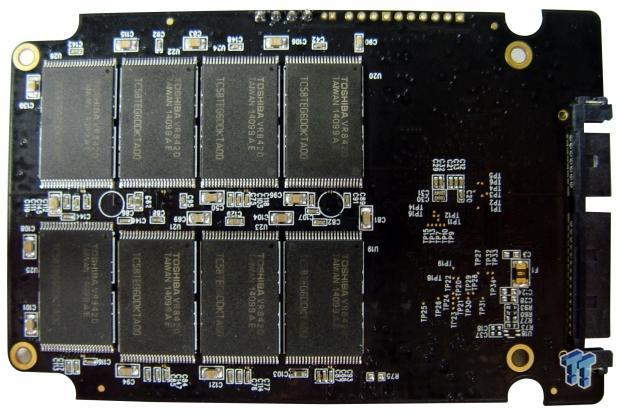
There are eight packages on each side.
JMicron JMF667H with Toshiba A19 240GB
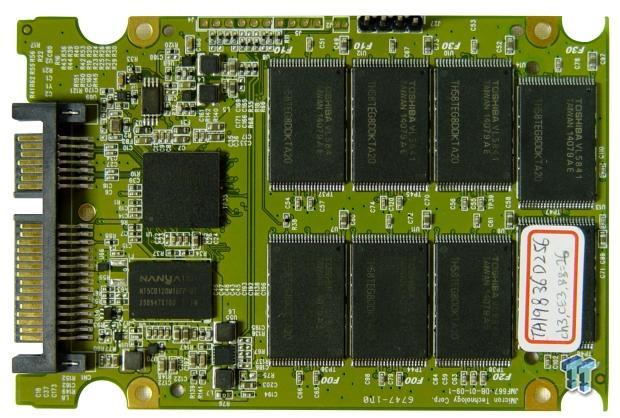
The final drive in our roundup uses the JMF667H controller with Toshiba's A19 flash. There are eight flash packages with four times the density as the 128GB model above. This model also has more overprovisioning than the three other drives we're looking at today: 240GB is user available with 256GB total.
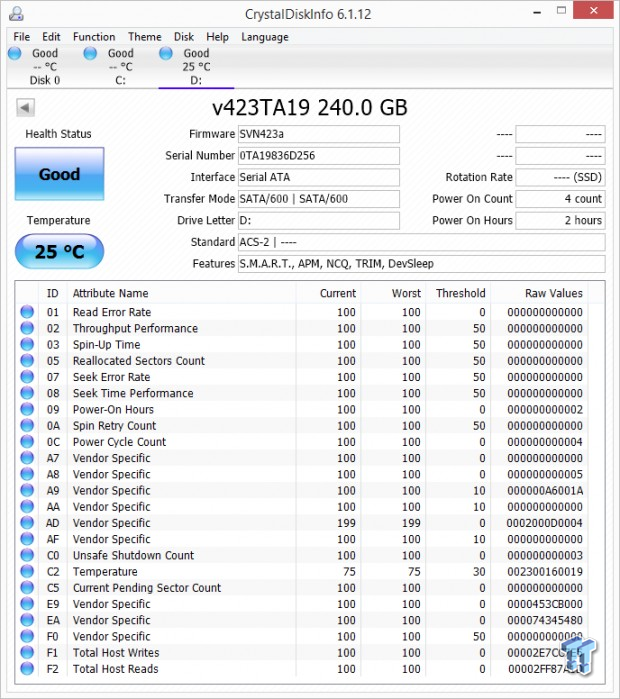
The firmware for this model appears to be a bit newer: SVN423a. Oddly enough, this is the only model we had any issues with during testing.
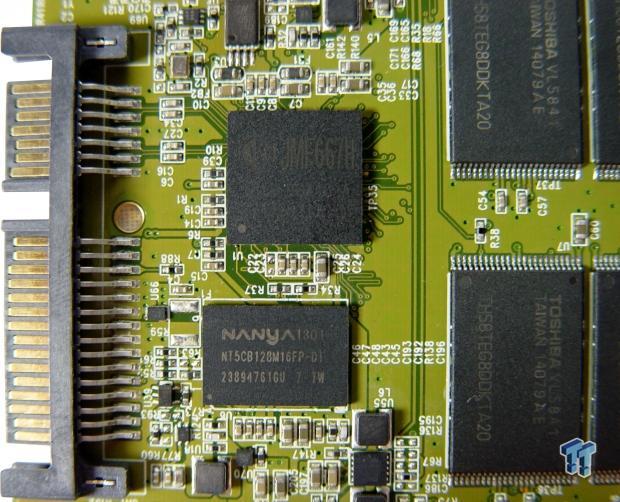
The SDRAM package is from Nanya, and it is 128MB.
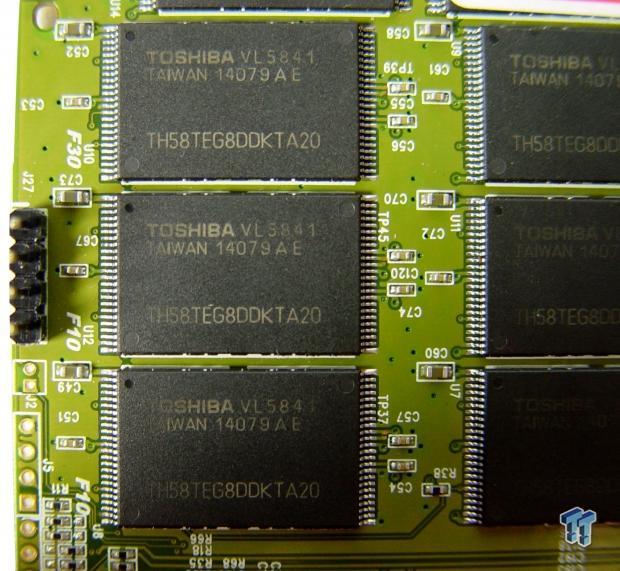
The flash is Toshiba TH58TEG8DDKTA20.
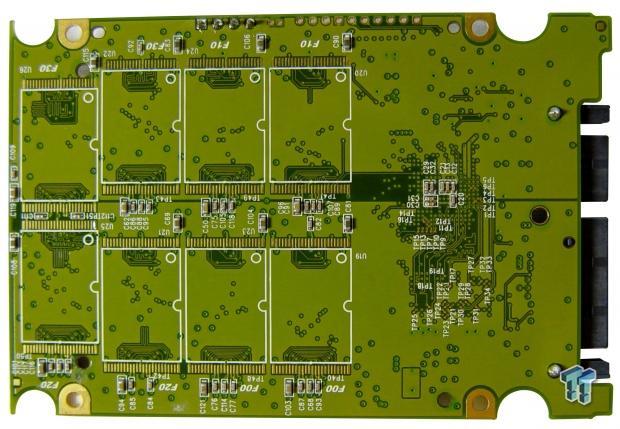
The PCB has pads on the back for additional flash, but this model only uses eight packages on the top side.
Test System Setup and ATTO Baseline Performance
Desktop Test System
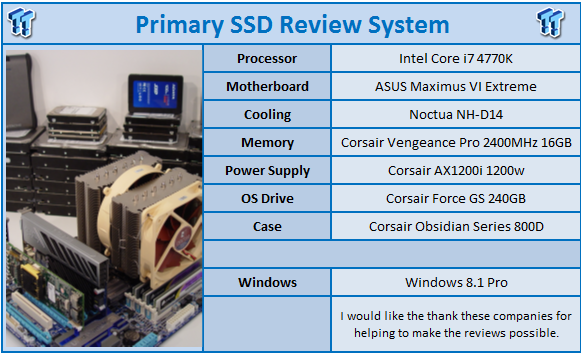
Lenovo W530 – Mobile Workstation
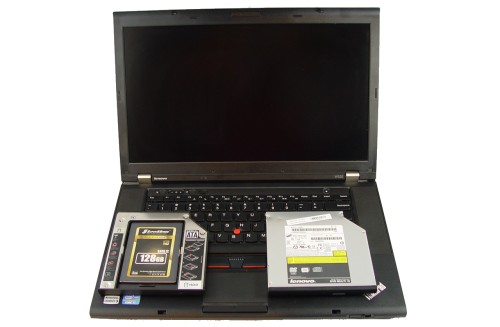
We use two systems for SSD testing. The desktop runs a majority of the tests, and the Lenovo W530 runs the notebook power tests as well as the real-world file transfer benchmark.
ATTO - Baseline Performance
Version and / or Patch Used: 2.34
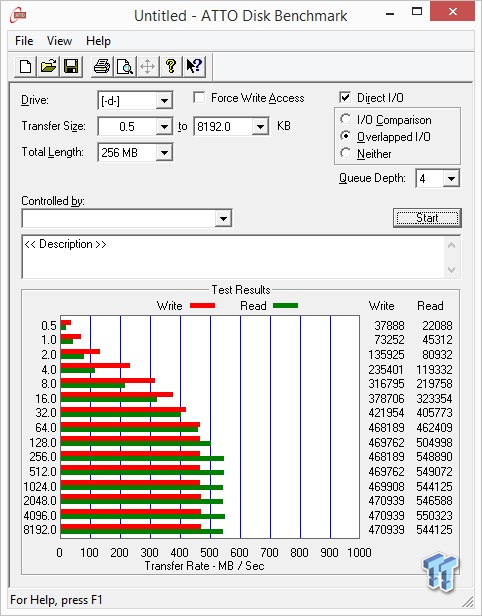
The fastest model we tested in the lot is the 240GB drive with Toshiba A19 flash. This model achieves 550 MB/s sequential read and 470 MB/s sequential write. The 128GB A19 model did achieve a higher sequential read speed in ATTO, nearly 560 MB/s, but the write speed was 327 MB/s.
The JMF667H drive with L85A (256GB) scored 533 MB/s sequential read but only 315 MB/s sequential writes. The L85C (128GB) scored well when reading sequential data, 556 MB/s, but the writes were all the way down to 155 MB/s.
Benchmarks – Sequential Performance
HD Tune Pro - Sequential Performance
Version and / or Patch Used: 4.55
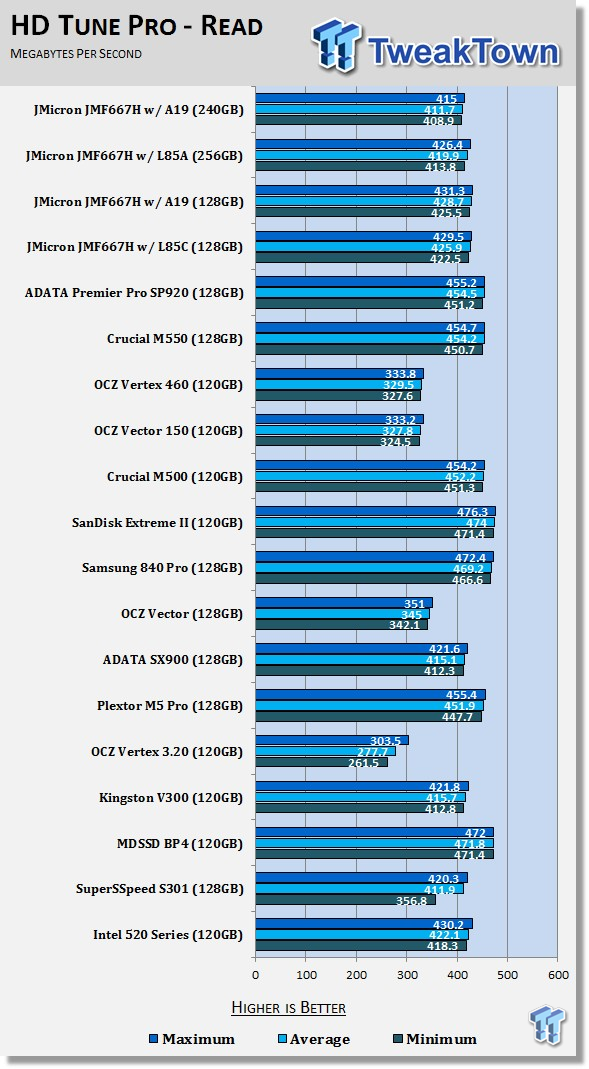
As noted on the previous page, all four drives score well in sequential read tests. Here we see a comparison in HD Tune Pro with 64kB block size tests.
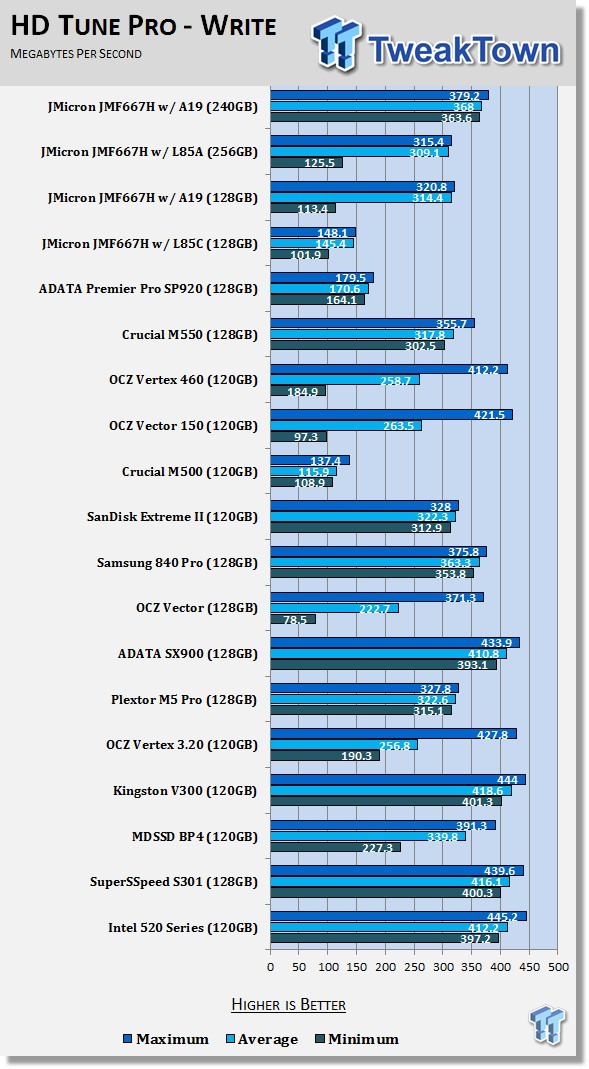
The sequential write performance was all over the map on the previous page, and this chart shows us the same deviation between models. We've suspected for a long time that Toshiba was pulling away from IMFT in flash performance, and this chart really backs up that theory.
HD Tach – Sequential Write Performance after Random Writes
Version and / or Patch Used: 3.0.4.0
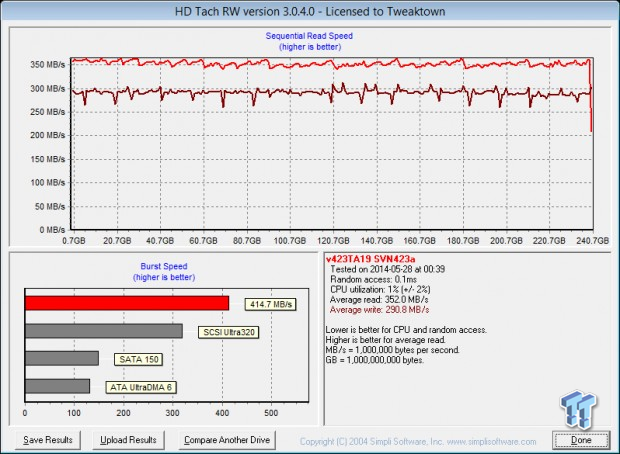
For this section, we're using the Toshiba A19 drives to look at performance after a reasonable number of random writes. The larger capacity size drives, regardless of flash type, did very well in this test.
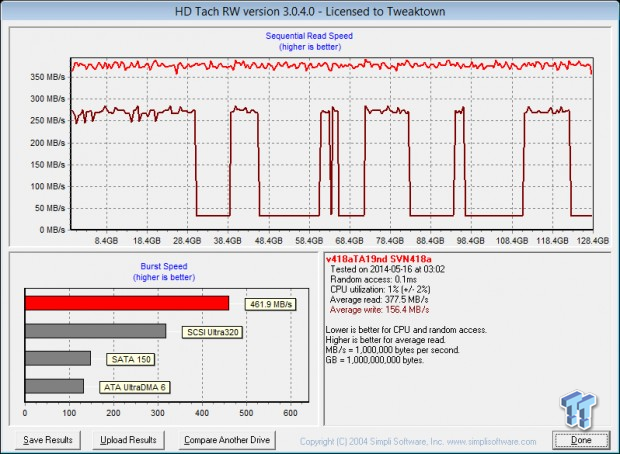
The two smaller capacity drives, both with 128GB of NAND flash, show significant reductions in sequential write performance due to the previous random data writes. This isn't all that odd as we've experienced this issue on several different products over the last couple of years.
Benchmarks - Anvil Storage Utilities
Anvil Storage Utilities
Version and / or Patch Used: RC6
So what is Anvil Storage Utilities? First of all, it's a storage benchmark for SSDs and HDDs where you can check and monitor your performance. The Standard Storage Benchmark performs a series of tests; you can run a full test or just the read or the write test, or you can run a single test, i.e. 4k QD16.
Anvil Storage Utilities is not officially available yet, but we've been playing with the beta for several months now. The author, Anvil on several international forums, has been updating the software steadily and is adding new features every couple of months.
The software can be used several different ways to show different aspects for each drive. We've chosen to use this software to show the performance of a drive with two different data sets. The first is with compressible data, and the second data set is incompressible data. Several users have requested this data in our SSD reviews.
0-Fill Compressible Data
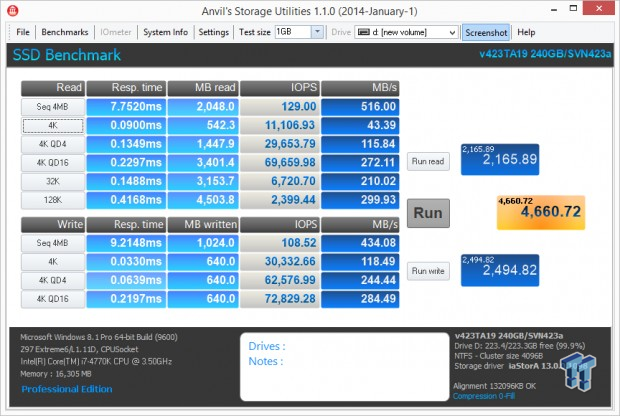
Incompressible Data
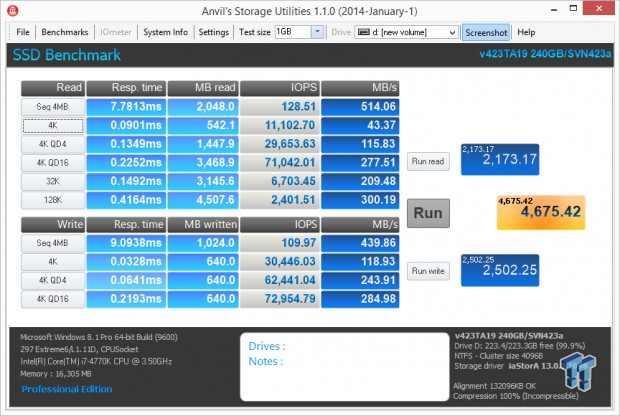
The JMicron JMF667H controller works with compressible and incompressible data the same way in all capacity sizes and flash types.
Read IOPS through Queue Depth Scale
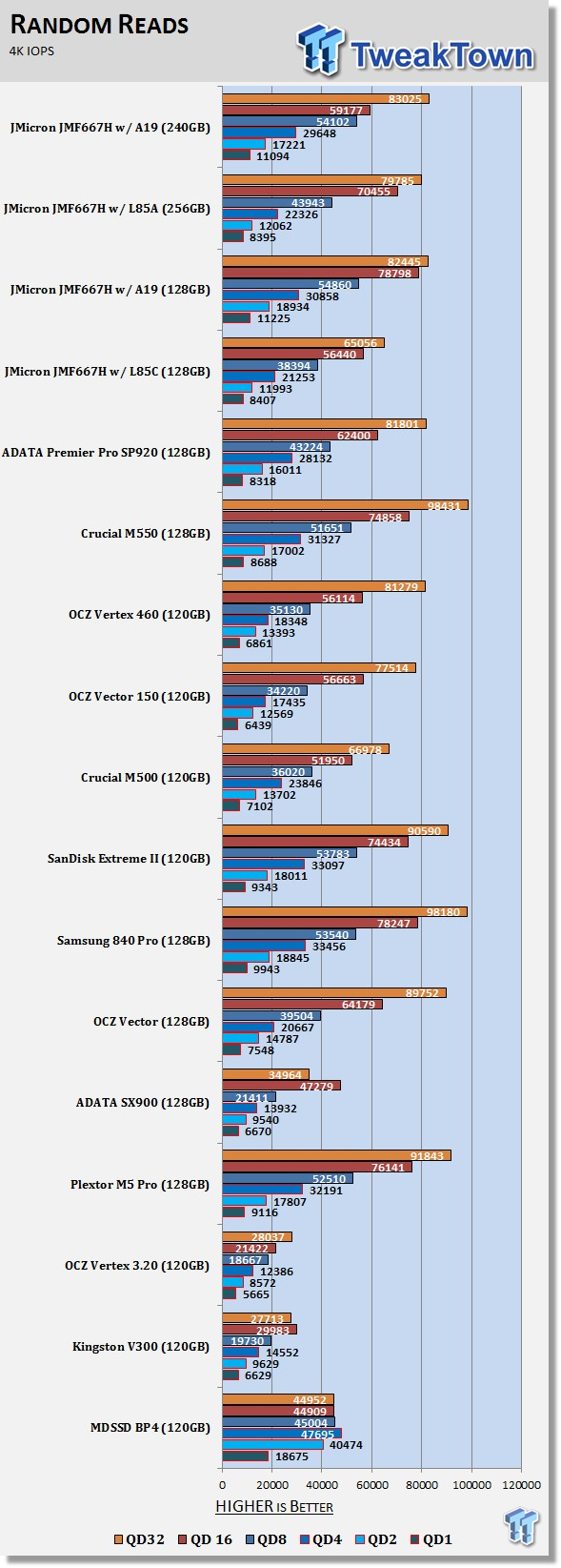
The difference between QD1 performance when comparing IMFT and Toshiba flash is interesting. The Toshiba flash scores over 11,000 IOPS, but the IMFT flash only manages to achieve around 8,400 IOPS.
Scaling Write IOPS through Queue Scale
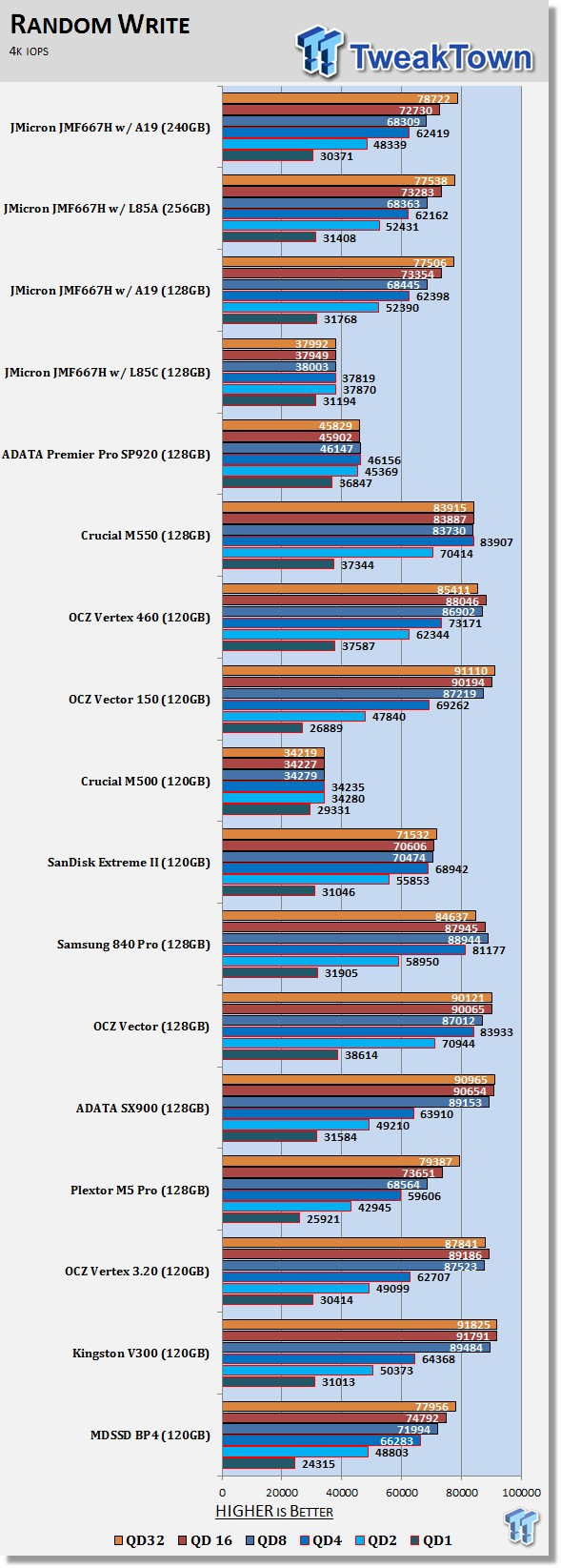
Nothing on this chart comes of great surprise. We do get to see the L85 brick wall at roughly 38,000 write IOPS in the 128GB capacity size. We've seen this on other controllers as well for smaller capacity drives.
The other drives all top out around 78,000 write IOPS at QD32.
Benchmarks - PCMark Vantage (Drives with Data Testing)
Version and / or Patch Used: 1.0.0
For a complete breakdown on the Drives with Data Testing, please read this article. You will be able to perform this test at home with the files provided in the article; full instructions are included.
Brief Methodology
SSDs perform differently when used for a period of time and when data is already present on the drive. The purpose of the Drives with Data testing is to show how a drive performs in these 'dirty' states. SSDs also need time to recover, either with TRIM or onboard garbage collection methods.
Drives with Data Testing - 25%, 50%, 75% Full States and Dirty / Empty Test
Files needed for 60 (64GB), 120 (128GB), 240 (256GB)
60GB Fill – 15GB, 30GB, 45GB
120GB Fill - 30GB, 60GB, 90GB
240GB Fill – 60GB, 120GB, 160GB
Empty but Dirty - a test run just after the fill tests and shows if a drive needs time to recover or if performance is instantly restored.

Despite the A19 advantage until this point, IMFT flash performs better with data on the drives. This is more in line with how people use SSDs rather than how most benchmark them. The smaller capacity drives tend to do better here as well because the flash translation tables are smaller. SSDs are dynamic in many ways, and there are tradeoffs around every corner.
PCMark 8 Consistency Test
Futuremark PCMark 8 Extended – Consistency Test
Version and / or Patch Used: 2.0.228
Heavy Usage Model:
FutureMark's PCMark 8 allows us to wear the test drive down to a reasonable consumer steady state and then watch the drive recover on its own through garbage collection. To do that, the drive gets pushed down to steady state with random writes and then idle time between a number of tests allows the drive to recover.
Precondition Phase:
1. Write to the drive sequentially through up to the reported capacity with random data.
2. Write the drive through a second time (to take care of overprovisioning).
Degradation Phase:
1. Run writes of random size between 8*512 and 2048*512 bytes on random offsets for 10 minutes.
2. Run performance test (one pass only).
3. Repeat 1 and 2 for 8 times, and on each pass increase the duration of random writes by 5 minutes.
Steady state Phase:
1. Run writes of random size between 8*512 and 2048*512 bytes on random offsets for 50 minutes.
2. Run performance test (one pass only).
3. Repeat 1 and 2 for 5 times.
Recovery Phase:
1. Idle for 5 minutes.
2. Run performance test (one pass only).
3. Repeat 1 and 2 for 5 times.
Storage Bandwidth
PCMark 8's Consistency test provides a ton of data output that we use to judge a drive's performance.
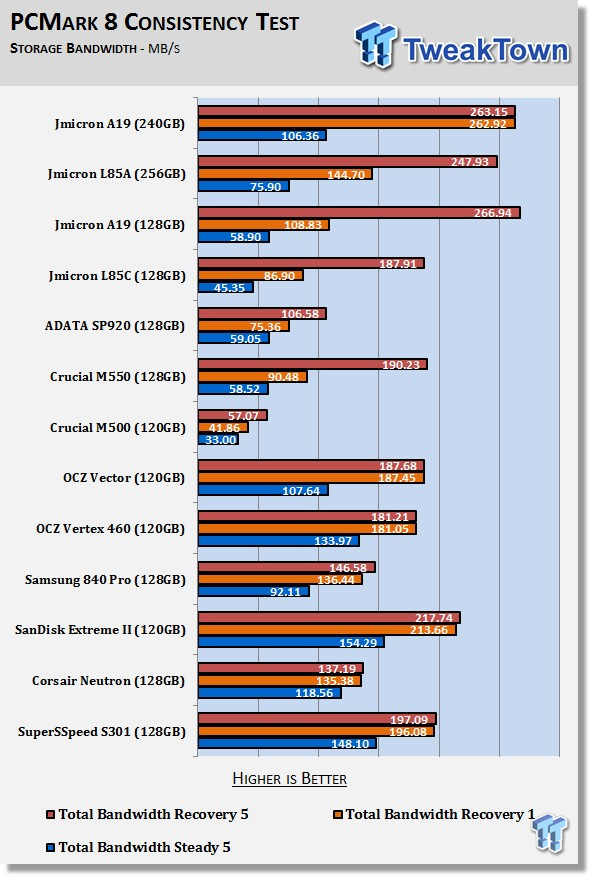
All four of the JMicron reference design samples lose a lot of performance when the flash is in a dirty state. The A19 model with 240GB of user capacity recovers much faster than the other drives, but the A19 128GB model delivers the highest real-world performance when recovered.
As you can see on the chart, recovery performance is very high on these drives in real-world tests. Now we understand why JMicron was so excited to send us reference design hardware with the latest firmware.
Consistency – All Tests
Here we see all of the tests plotted on the same chart. This shows the drive from worst case to steady state to recovery performance.
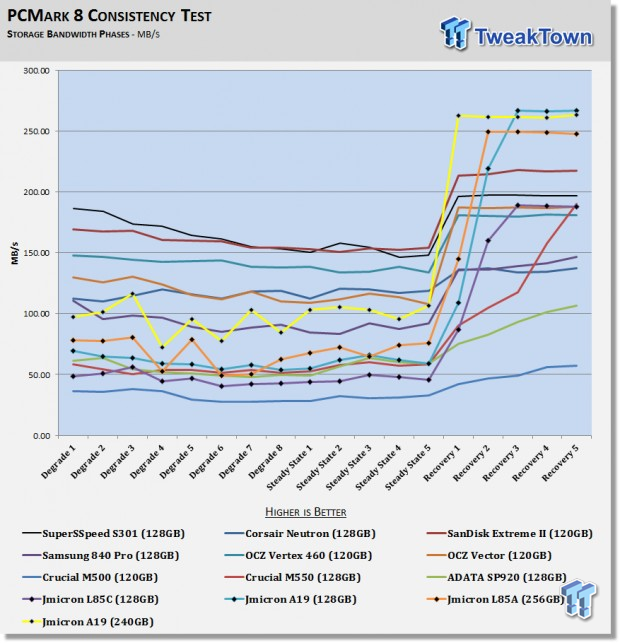
Here we see all of the tests. Three of the four drives recover very well when compared to the other 128GB capacity class drives on the market. They are also higher than SanDisk's Extreme II after recovery, our highest performer in this capacity size and one of the most consistent drives on the market.
Sadly, the JMicron drives can't keep the same level of performance all the way through. While the JMF667H hits high marks when clean, the dirty states show poor performance. The difference between is quite wide, but JMIcron's market is users not writing a lot of data to the flash per day. That leaves the drive in a relatively clean state most of the time.
PCMark 8 Consistency Test - Continued
Total Access Time
The access time test measures the total latency across all 18 tests. This is one of the most important tests we run at this time for consumer SSDs. When your latency is low, your computer feels fast; it's just that simple.
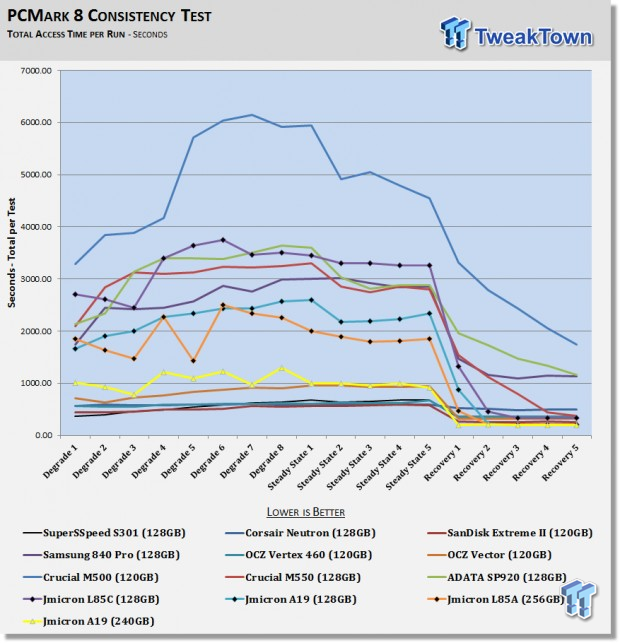
Here we see the latency test. I marked the A19 240GB drive a little differently and in yellow to show how much different that drive is compared to the others. Not only does the A19 240GB have less latency than the others, but it also delivers some of the lowest latency of all the drives compared here when in a clean state.
Disk Busy Time
In the final test, we measure the amount of time the drive worked to read and write the data to complete the test. When a drive is active, it uses more power, so the faster it can complete the tasks, the faster it can fall into a low power state.
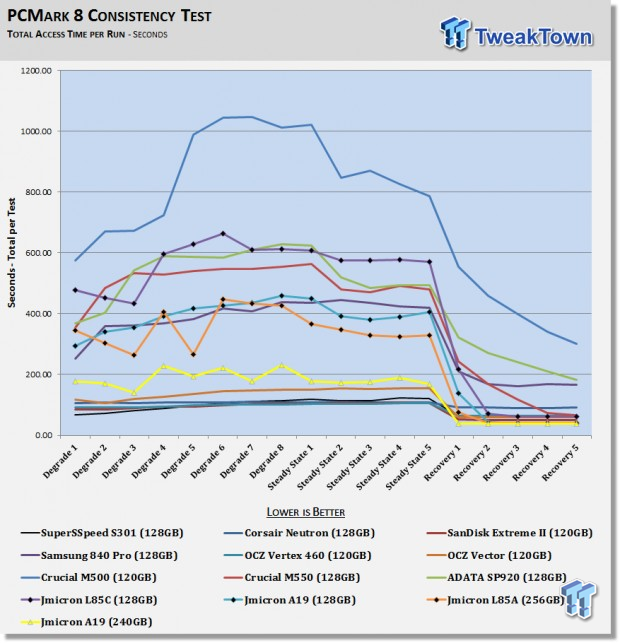
Even though we didn't test power in this preview due to the JTAGs and limited time, I would suspect the A19 240GB model delivers longer battery life than the other three drives we tested today. The less a drive has to work, the faster it can get to a lower power state.
Final Thoughts

We were surprised when JMicron reached out to us directly for this article. We work closely with all of the other flash controller manufacturers but have never met with or even spoken directly to JMicron. During our testing, nothing really stuck out as being all that impressive until we started running real-world applications testing. With the flash clean, the JMF667H is a very good controller, but the controller needs to be paired with the right flash. At this time, that means Toshiba A19 Toggle 2.0 and in a larger capacity size.
On the retail side, we've already tested two products with the JMF667H controller. The first resulted in decent mainstream performance at a low price point. The first test was on the Kingfast C-Drive F8. Our second JMF667H review came from the Transcend SSD340, and its performance was significantly slower. We've spoken with Transcend several times about the issue and expect a new firmware at some point from the company.
JMicron's new firmware is much better than the retail drives we've tested. The new firmware paired with Toshiba A19 in 240GB capacity is very strong, but only under the right conditions. JMicron managed to increase the relatively clean performance, but with the dirty flash, performance suffers greatly.
The one thing that really sticks out in my mind is this fact. JMicron is just now getting good performance from the company's SATA controller, but at this time, others like Marvell, Phison, and SandForce are shifting engineers over to PCIe based controllers. It's better late than never, but clearly JMIcron is still trailing the pack. That could change now that the company is willing to reach out to third-party testers and get our feedback.
Time will tell, but JMicron's enthusiasm to get this article on the site tells us the company is ready to work to get to a leadership position.
